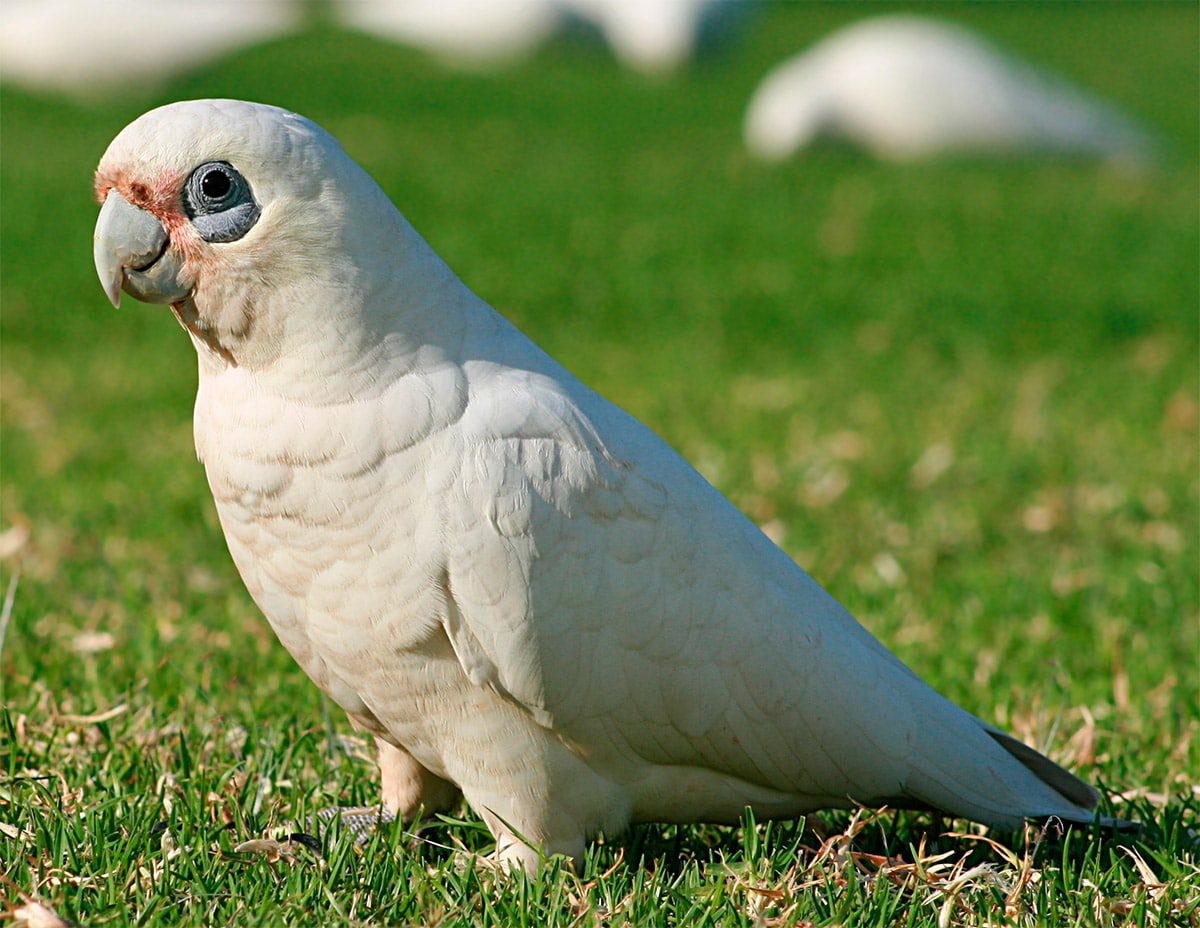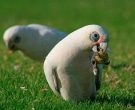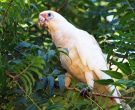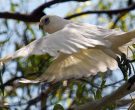Content |
|---|
Description
It measures 35-40 cm.. and weighs approximately 500 g..
In the Little corella (Cacatua sanguinea), the head and crest (that most of the time stays low) are white. The pink base of the feathers are almost completely hidden and yet barely visible small flakes in the cheeks.
Dissemination of salmon-rosa color to the area around the eyes. The upperparts and coverts of the wing are white. There is a remarkable spread of yellow color on the bottom of the flight feather and of the tail.
The bill is grayish white. The skin nude around the eyes is blue grey. The irises is dark brown, the legs grey.
Both sexes are identical in all aspects, including the color of the irises.
The immature have a look more white and the skin of the periphery eyepiece less prominent.
- Sound of the Little corella.
Habitat:
Video – "Little corella" (Cacatua sanguinea) |
|---|
It nests in riparian forests bordering permanent pasture and cropland. In the breeding season, they can be found in a wide variety of habitats, including areas of acacias and eucalyptus bushes of short grass or pasture with groups of scattered trees. During this time, they are also present in the rice fields, cane extensions, areas of shrubs, at the edges of mangrove areas, in the pastures for horses, on roads and gardens on the outskirts of cities.
Behavior:
The Bloody Cockatoos they often form large gatherings in crops and pastures.
Out of it breeding season, It is not uncommon to see flocks of up to 70.000 birds.
At night they fly to their bedrooms, located near the water.
Early in the morning, they drink before heading to the feeding sites often many kilometres from the bedroom.
During the hottest hours of the day, they seek shelter in the shade of the leaves..
Reproduction:
In Australia they can be played back in any month of the year, When are conditions good. But, the nesting seems to be further developed early in the North (from May to October) and in the Southeast (August-December).
In Queensland, the implementation is carried out mainly from December to April and from July to October. Reproduction is strongly influenced by climate, usually begins 2 or 3 months after the end of the rainy season in northern districts.
There may be two or three broods per season. Couple ties are very strong and seem to last for life. They are loyal to the same nesting sites year after year. The nest is usually placed in a eucalyptus (Eucalyptus camaldulensis) between 3 and 10 meters above the ground.
The cavity is approximately one meter in depth. It is fairly easy to detect since crust is often removed around inlet. They also nest on cliffs or termite mounds..
They put 2-4 eggs in a bed made from chips of wood that is replaced each year.
In general, two chicks manage to break the shell after 25 days. They remain in the nest for nine weeks, After this take off.
Food:
It has a diet mainly vegetarian. They feed on seeds you are in the trees of the genus EMEX, green areas or fields of melon (cucumber myriocarpus). They also eat nuts, fruit, berries, flowers, estate, bulbs, shoots as well as insects and larvae.
Distribution:
Size of the area of distribution (reproduction / resident): 5.300.000 km2
The Little corella lives in New Guinea and Australia. In Australia, We found in the Northwest, on the plateau of Kimberley and Arnhem in the this of the Cape York Peninsula. They are absent from the east coast and the entire southwestern part of the country..
Conservation:
State of conservation ⓘ |
||
|---|---|---|
 Minor Concern ⓘ
(UICN)ⓘ
Minor Concern ⓘ
(UICN)ⓘ
| ||
• Current IUCN Red List category: Least concern.
• Population trend: Growing.
Its population is estimated at more than 1 million of birds and it believes that is in constant increase, especially in the South of Australia.
Its growth and expansion depends on the development of agriculture and the availability of artificial reservoirs. It is a Bird protected, except in the the Australia South. In this last area, the landowners are allowed to kill birds to prevent the formation of large destructive meetings for crops.
"Little corella" in captivity:
The Australian poultry to the blood cockatoo is it considered common.
They are very docile and Welcome to as pets, but you must pay them attention.
Alternative names:
– Little Corella, Bare-eyed Cockatoo, Bare-eyed Corella, Blood-stained Cockatoo, Blue-eyed Cockatoo, Corella, Dampier’s Corella, Little Cockatoo, Short-billed Cockatoo, Short-billed Corella (ingles).
– Cacatoès corella, Cacatoès à oeil nu (French).
– Nacktaugenkakadu (German).
– Cacatua-corella-pequena (Portuguese).
– Cacatúa Sanguínea (español).
scientific classification:
– Order: Psittaciformes
– Family: Cacatuidae
– Genus: Cockatoo
– Scientific name: Cacatua sanguinea
– Citation: Gould, 1843
– Protonimo: Cacatua sanguinea
Blood Cockatoo Images:
Sources:
– Avibase
– Photos: Wikipedia, John H. Boyd, murrundi.org
– Sounds: Nigel Jackett (Xeno-canto)





